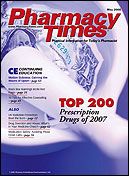Publication
Article
Pharmacy Times
newsCAPSULES
KEY ROLE FOR PHARMACISTS IN EDs
The director of the federal Agency for Healthcare Research and Quality (AHRQ) is calling for use of pharmacists in emergency departments (EDs), the American Society of Health-System Pharmacists (ASHP) reports.

Writing in the March 2008 issue of the Journal of Patient Safety, AHRQ Director Carolyn Clancy, MD, emphasizes the growing need to employ pharmacists to reduce the risk of adverse drug events in the EDs, which have a complex nature and fast pace that increase the likelihood of such events.
The AHRQ has collaborated with ASHP in launching the program, "Introducing an Emergency Pharmacist into Your Institution."
IMPROVED HEPARIN TESTS UNDER WAY

The United States Pharmacopeia (USP) Convention is working with the FDA to develop more sensitive methods for detecting contaminants recently found in heparin. This contamination is suspected in causing severe allergic reactions in some patients and >60 deaths.
Over-sulfated chondroitin, the suspected contaminant, is derived from the dietary supplement chondroitin. The chemically induced over-sulfated form can imitate blood-thinning properties. Thus, heparin adulterated in this manner may pass existing quality tests.
After the recall in January of suspect heparin products, the FDA in March reached out to USP to help in reassessing current tests and possibly creating new methods for detecting over-sulfated chondroitin in the heparin drug substance before it is made into the final product. The work is continuing and will result in updated heparin monographs.
PEDIATRIC ERRORS CAUSE ALARM
The Joint Commission?s latest Sentinel Event Alert calls on health care organizations to improve pediatric safety after recent findings that 1 out of every 15 hospitalized children are harmed by a drug error or adverse reaction.
Most of the harmful pediatric medication errors tracked during the past 2 years by United States Pharmacopeia involved either an improper dose or quantity. Problems typically arise when hospitals and clinics must prepare special volumes or concentrations because the drugs are formulated and packaged primarily for adults.
The commission is calling for greater attention to medication standardization, improved medication identification and communication techniques, and the use of kilograms as the standard measurement when weighing pediatric patients so that proper dosages can be calculated.
Included in the alert?s recommendations are requirements that prescribers write how they arrived at the proper dosage?as dose per weight?so it can be double-checked by a pharmacist, nurse, or both. The alert also urges the use of pediatric-specific medication formulations and concentrations when possible. Visit www.jointcommission.org for more information.
A BROADER ROLE FOR HOSPICE PHARMACY GROUP
The American College of Hospice Pharmacists expanded recently to encompass pain pharmacy, a move intended to reflect a broader role for the specialty group, which was established by the American College of Apothecaries (ACA) in 2006.

Now known as the American College of Hospice and Pain Pharmacy (ACHPP), the organization will be offering a wider range of programs and is shifting its focus to pain management for all patients, according to ACA Executive Vice President DC Huffman, PhD.
"With so many new developments in palliative care emerging all of the time, we want to reach as many pharmacists as possible," said Dr. Huffman. "We feel the name change and the refocusing of our specialty group will expand the base of pharmacists we can help. While not every pharmacist works with hospice, nearly every pharmacist comes in contact with the area of pain management."
To keep pain management pharmacists up to date on the latest news, research, and trends, the ACHPP will distribute newsletters and special publications, as well as continue to provide continuing education courses and consultant services in hospice care and pain management.
NPI ON CLAIMS TO TAKE EFFECT
As of May 23, the Centers for Medicare & Medicaid Services (CMS) is requiring all pharmacies to submit a prescriber?s National Provider Identifier (NPI) on all prescription drug claims to get reimbursed for Medicare and Medicaid prescriptions.
Prescription drug claims will be rejected when a prescriber does not have an NPI. Patients whose physicians have not gotten an NPI may be unable to receive their medications or may have to pay out of pocket.
"Approximately one third of prescribers do not have an NPI yet," said Steven C. Anderson, IOM, CAE, president and chief executive officer for the National Association of Chain Drug Stores. "We want to work with prescribers to achieve universal NPI compliance and ensure that Medicare and Medicaid patients get their medications."
NPIs were originally scheduled to take effect May 23, 2007. CMS agreed to delay full implementation of the requirement after receiving complaints from insurers and health care providers.
TREND CONTINUES FOR RxTO OTC SWITCHES
The markets for Rx to OTC switches could reach $5 billion in 2008 and increase by nearly 40% by 2010, according to "The Return of the Rx to OTC Switch: Market Analysis and Product Management Strategies," a new report from Kalorama Information.

In 2006, 14 prescription drugs surpassed $20 billion in sales and may have the potential to reach the OTC market in 4 years. The report indicated that more than half of the 2008 revenues will be from allergy medications that already made the switch, such as Claritin (loratadine), Mucinex, and Zyrtec (cetirizine HCI). The reasons behind the increase in Rx to OTC switches are attributed to patent expirations, generic competition, petitions to the FDA, and drug safety and efficacy.
"Lagging FDA approvals led to a brief absence of Rx to OTC switches in the pharmaceutical marketplace, but 2006 and 2007 saw a number of switches," said Melissa Elder, the report's author. "We believe this product management tactic will continue to be aggressively utilized as companies seek ways to extend revenue lifestyles."
TOOLKIT AIMS TO HELP PROTECT PHARMACIES
The National Community Pharmacists Association (NCPA), FBI LEEDA (Law Enforcement Executive Development Association), and Purdue Pharma L.P. are serious about combating pharmacy crimes and have made available the Protect Your Pharmacy Now! toolkit with resources to assist them in improving pharmacy security.
The toolkit, free for NCPA members, includes a window poster, decal, and a free RxPATROL (Pattern Analysis Tracking Robberies and Other Losses) training DVD on pharmacy crime. NCPA members also will receive information on closed-circuit TV cameras, recorders, and surveillance equipment.
Launched in 2003, RxPATROL is a joint effort between the pharmaceutical industry, pharmacy community, and law enforcement to track pharmacy crime information. For a related article, visit www.PharmacyTimes.com/combatcrime.







